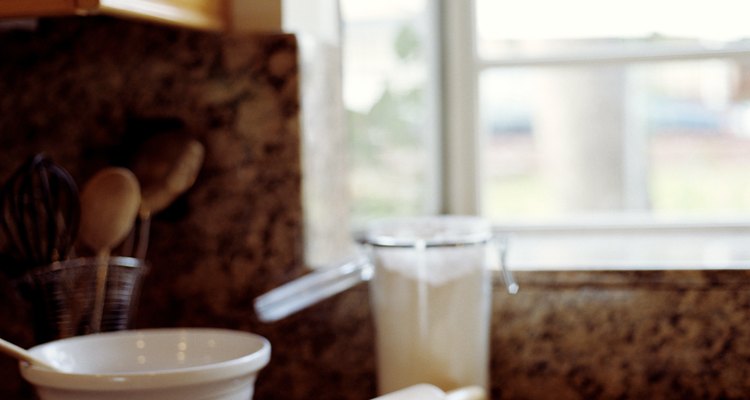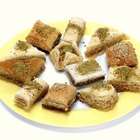
A pie that brims with seasonal fruit, savory tarts, golden turnovers -- one thing they have in common is a well-made crust. A flaky, tender crust usually requires more time in the kitchen than most moms have to spare. By using frozen shortcrust pastry, you can create tantalizing pastry in less time and with minimal effort
Rolling Out the Dough
Step 1
Clean and dry your work surface. A large cutting board is a good choice if you don’t have the counter space to roll out the dough. Sprinkle the surface with flour. Place the thawed pastry dough on the surface, and lightly sprinkle flour on top.
Step 2
Dust the rolling pin with flour. Start with the edge closest to you and begin to roll out the dough. Roll out 2 or 3 times, each time rolling away from you, while applying firm pressure with the rolling pin.
Step 3
Turn the dough a quarter turn, sprinkling more flour on the work surface and dough if it starts to stick. Continue to roll out the dough, turning every 2 to 3 rolls. This helps ensure the dough will not shrink during baking. Once the dough has reached the desired size and thickness at 3- to 5-mm thick, it is ready to place in a pie tin, tart pan or baking sheet.
Step 4
Place the rolling pin along one edge of the dough. Slowly begin rolling the pin, this time allowing the dough to catch and roll up with the pin. Lift the rolling pin, with the dough, and move to the pie tin or baking sheet. Unroll the dough, allowing it to fill the tin or lay flat on the baking sheet. The dough is now ready to use in your favorite recipe.
Pies and Tarts -- Savory and Sweet
Step 1
Prepare your desired filling, per your recipe. Allow the filling to cool. While it is cooling, roll out the dough as directed above, and place in a pie or tart pan.
Step 2
Fill the pie or tart with the cooled filling. Fruit pies are a popular choice for dessert, while savory fillings, like chicken and mushrooms, make for a hearty meal.
Step 3
Roll out a second sheet of pastry dough, about two inches larger in diameter than the bottom crust. Lifting the dough with the rolling pin, arrange it over the filled pie or tart and unroll. Some dough should hang slightly over the edge of the pan.
Step 4
Press the dough firmly down around the edges, so that you a tight seal forms between the bottom and top crusts. If any dough hangs down, trim it with a knife.
Step 5
Cut 2 to 4 small slits in the top crust, which will allow steam to escape during baking. Bake as directed in your recipe.
Related Articles

The Best Way to Roll Out Pizza Dough
Easy Cinnamon Roll Recipe

How to Make Thin Extra Crispy Pizza ...

How to Use a Lattice Pie Cutter

Quick Method for Thawing Frozen Bread ...

How to Freeze an Unbaked Pizza Crust

How to Add Butter to Biscuits While ...

How to Preserve Fondant

Shortbread Cookie Recipe

Good Substitute for Puff Pastry

How to Quickly Defrost Phyllo

How to Cook With Filo Dough

How to Freeze Stromboli

How to Make Flour Tortillas With Olive ...
How to Make a Pie Crust Brown at the ...

Can I Make Doughnuts From Frozen Yeast ...

How to Make Pineapple Empanadas

How to Preserve Homemade Pizza Dough

Pop-Tart Pie Recipe

Desserts That Can Be Made With Puff ...
References
Writer Bio
An educator since 1998, Catherine Misener started her writing career in 2009. Her work has appeared in "NW Kids," "The Oregonian" and "Vancouver Family Magazine." She holds a Bachelor of Arts from St. Mary’s University and a Master of Arts from the University of Michigan. After working in the food industry for years, she opened a small batch bakery.
Photo Credits
Siri Stafford/Digital Vision/Getty Images